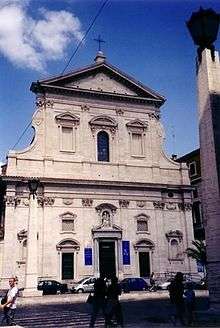Santa Maria in Traspontina
| Santa Maria in Traspontina | |
|---|---|
 Façade seen from Via della Conciliazione. | |
| Basic information | |
| Location |
|
| Geographic coordinates | Coordinates: 41°54′10″N 12°27′44″E / 41.90278°N 12.46222°E |
| Affiliation | Roman Catholic |
| Country | Italy |
| Ecclesiastical or organizational status | Titular church |
| Architectural description | |
| Architect(s) | Giovanni Sallustio Peruzzi |
| Architectural type | Church |
Santa Maria in Traspontina (or Transpontina) is a Carmelite church in Rome, Italy. The shrine lies on the Via della Conciliazione, the main road of the Rione Borgo.
The church was established as a cardinalatial titulus by Pope Sixtus V on 13 April 1587.[1] The current Cardinal Priest of Santa Maria in Traspontina is the former Archbishop of Quebec, Marc Ouellet, a supporter of Opus Dei,[2] who is now the Prefect of the Sacred Congregation of Bishops in the Roman Curia.
History
Pope Alexander VI demolished an ancient Roman pyramid on the same site (the Meta Romuli, believed in the Middle Ages to be Romulus's tomb, and portrayed on the bronze doors to St Peter's Basilica and in a Giotto di Bondone triptych in the Vatican Museums) for the construction of the first church. This church was then demolished during the pontificate of Pius IV (1559–1565) to clear the line of fire for the cannons of the Castel Sant' Angelo, who wished to exercise shooting on the Gianicolo Hill, which otherwise would have been hidden behind the church.
Designs by Giovanni Sallustio Peruzzi (with contributions by Ottaviano Nonni and Francesco Peparelli) for a replacement church were in place by 1566, though the papal artillery officers insisted that its dome be as low as possible to avoid a recurrence of the previous problem — for this reason this is the only church in Rome whose dome does not lie on a drum. The new church was erected along the North side of Borgo Nuovo, which was at that time - and until its destruction in 1937 - the main road of Borgo.
The inscriptions found in Santa Maria in Traspontina, a valuable source illustrating the history of the church, have been collected and published by Vincenzo Forcella.[3]
Interior
The church has four chapels on each side of the nave. The first on the right, is dedicated to Saint Barbara (the patron saint of gunners). This chapel has an altarpiece of Santa Barbara (c. 1597) by Cavalier d'Arpino, with frescoed scenes (1610–20) from the life of the saint by Cesare Rossetti. The second chapel has an Ecstasy of S. Canuto (1686) by Daniele Seyter, with frescoed ceiling and lunettes by Alessandro Francesi. The fourth chapel has a Madonna & St. John Evangelist (1587) by Cesare Conti with frescoes of the Passion (1649) by Bernardino Gagliardi. The fifth is dedicated to S.Alberto and the frescoed stories were by Niccolò Circignani. The crossing to the right, has an Apparition of the Trinity and 3 saints (1639) by Giovanni Domenico Cerrini.
The main altar (1674) was designed by Carlo Fontana, and has a medieval icon. The statues (1695) around the altar are by Alessandro Rondoni, Giacomo Antonio Lavaggi, Vincenzo Felici, and Michel Maille.
The chorus has canvases (1760) by Angelo Papi, while the ceiling of the left crossing (1697) was frescoed by Biagio Puccini. The fifth chapel to the left has an altarpiece by Giovanni Battista Ricci of Preaching by San Angelo Martire (1612) and stories of the saint. In the fourth chapel, a painting of the Ecstasy of Santa Teresa (1698) by Antonio Gherardi while the third has a Flagellazion of Saints Peter and Paul by Ricci, the second Santa Elia with St. Anthony Abbot and the blessed Franco da Siena painted by Giacinto Calandrucci.
One chapel contains the two columns to which Peter and Paul were said to have been bound prior to their martyrdom in the circus of Nero nearby.
References
- ↑ David M. Cheney, Catholic-Hierarchy: Santa Maria in Transpontina. Retrieved: 2016-03-20.
- ↑ Cardinal Ouellet and Opus Dei Retrieved: 2016-03-20.
- ↑ V. Forcella, Inscrizioni delle chiese e d' altre edifici di Roma, dal secolo XI fino al secolo XVI Volume VI (Roma: Fratelli Bencini, 1873), pp. 345-375.
Books
| Wikimedia Commons has media related to Santa Maria in Traspontina. |
- Rendina, Claudio (2000). Enciclopedia di Roma. Rome: Newton & Compton.